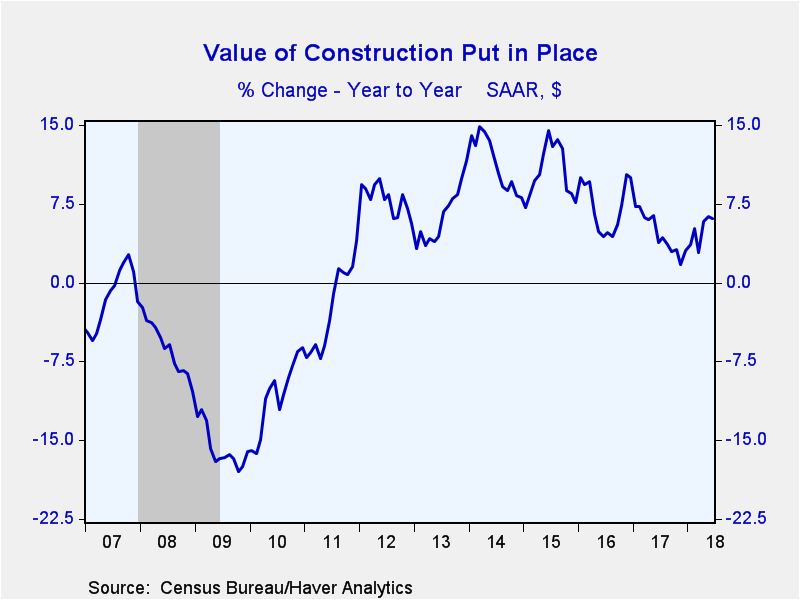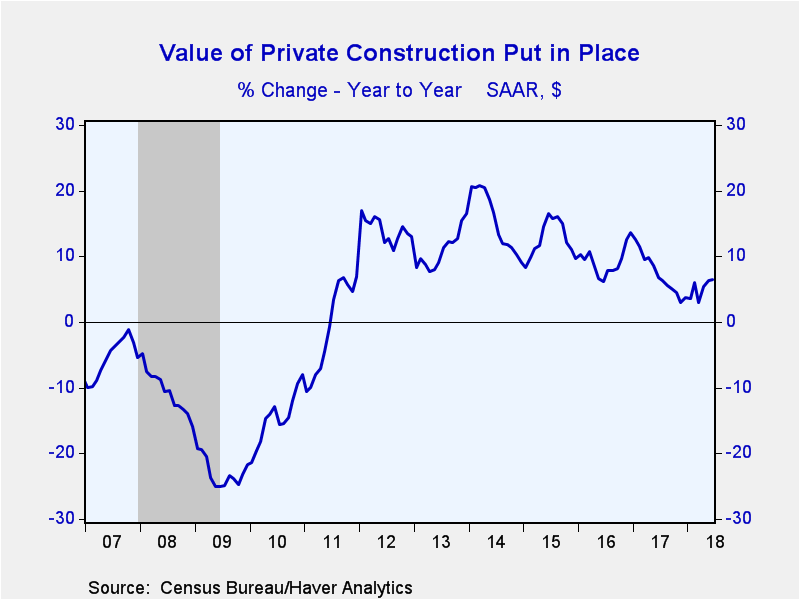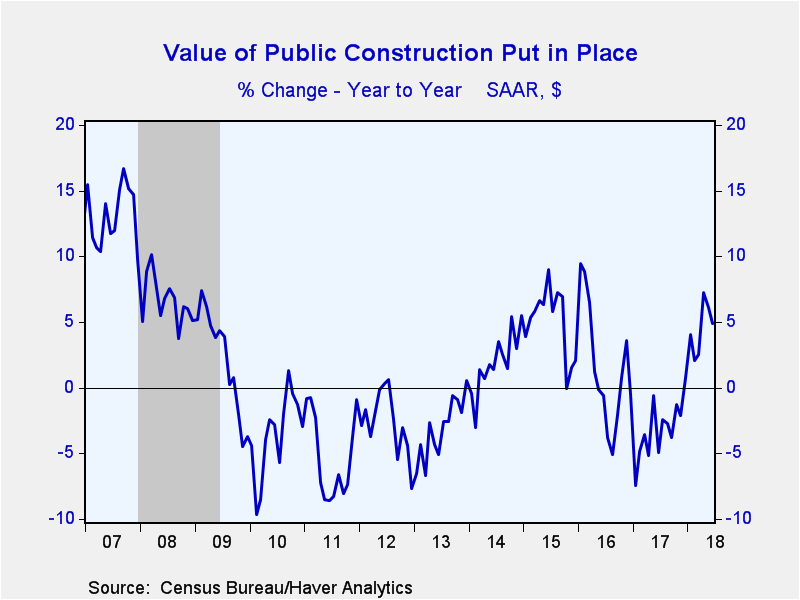 Global| Aug 01 2018
Global| Aug 01 2018U.S. Construction Spending Unexpectedly Falls in June
by:Sandy Batten
|in:Economy in Brief
Summary
The value of construction put-in-place unexpectedly fell in June, declining 1.1% m/m (+6.1% y/y) following solid, upwardly revised increases in both April and May. The April rise was revised from the initially reported 0.9% m/m [...]
The value of construction put-in-place unexpectedly fell in June, declining 1.1% m/m (+6.1% y/y) following solid, upwardly revised increases in both April and May. The April rise was revised from the initially reported 0.9% m/m increase to 1.7%; the May gain was revised from the initially reported 0.4% m/m to 1.3%. The consensus from the Action Economics Survey had expected a 0.3% m/m increase in June. For all of Q2, total construction spending rose 2.3%, down slightly from the 2.6% increase posted in Q1.
The weakness in June was widespread across all major categories—as was the significant upward revisions to April and May. Private sector construction spending slipped 0.4% m/m (+6.5% y/y) in June. Again, April and May were revised significantly stronger: April, initially reported at 0.4% m/m and revised to 1.7%; May initially 0.3% m/m and revised to 0.9%. For all of Q2, private sector construction spending rose 2.1% versus 2.8% in Q1. Private residential construction fell 0.5% m/m (+8.8% y/y) while nonresidential construction declined 0.3% m/m (+3.7% y/y). The weakness in residential construction in June was concentrated in multi-family dwellings, which fell 2.8% m/m. Spending on improvements edged up 0.1% m/m in June for the third consecutive monthly increase. For private nonresidential construction spending, 6 of the 11 major categories experienced declines in June while the other 5 experienced increases.
The value of public sector building slumped 3.5% m/m in June (+4.9% y/y) with opposing revisions to April and May. Public construction in May was revised up to 3.0% m/m from the initially reported 0.7% gain while the initially reported 2.3% m/m increase in April was revised down to 1.4%. Lower construction spending in Education accounted for 80% of the decline in public spending in June. Reduced spending on highways and streets (the largest component of public construction spending) accounted for another 12% of the overall decline in June.
The construction spending figures, some of which date back to 1946 (e.g., public construction figures), are in Haver's USECON database and the expectations figure can be found in the AS1REPNA database.
| Construction Put in Place (SA, %) | Jun | May | Apr | Jun Y/Y | 2017 | 2016 | 2015 |
|---|---|---|---|---|---|---|---|
| Total | -1.1 | 1.3 | 1.7 | 6.1 | 4.5 | 7.0 | 10.7 |
| Private | -0.4 | 0.9 | 1.7 | 6.5 | 7.1 | 9.2 | 12.9 |
| Residential | -0.5 | 1.3 | 3.1 | 8.8 | 12.4 | 10.7 | 14.2 |
| Nonresidential | -0.3 | 0.2 | 0.1 | 3.7 | 1.3 | 7.7 | 11.5 |
| Public | -3.5 | 3.0 | 1.4 | 4.9 | -3.2 | 0.7 | 5.1 |
Sandy Batten
AuthorMore in Author Profile »Sandy Batten has more than 30 years of experience analyzing industrial economies and financial markets and a wide range of experience across the financial services sector, government, and academia. Before joining Haver Analytics, Sandy was a Vice President and Senior Economist at Citibank; Senior Credit Market Analyst at CDC Investment Management, Managing Director at Bear Stearns, and Executive Director at JPMorgan. In 2008, Sandy was named the most accurate US forecaster by the National Association for Business Economics. He is a member of the New York Forecasters Club, NABE, and the American Economic Association. Prior to his time in the financial services sector, Sandy was a Research Officer at the Federal Reserve Bank of St. Louis, Senior Staff Economist on the President’s Council of Economic Advisors, Deputy Assistant Secretary for Economic Policy at the US Treasury, and Economist at the International Monetary Fund. Sandy has taught economics at St. Louis University, Denison University, and Muskingun College. He has published numerous peer-reviewed articles in a wide range of academic publications. He has a B.A. in economics from the University of Richmond and a M.A. and Ph.D. in economics from The Ohio State University.










